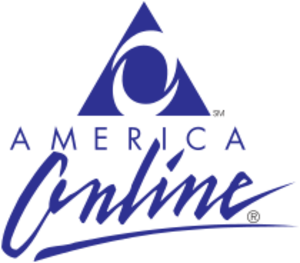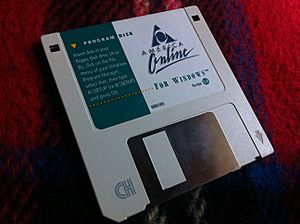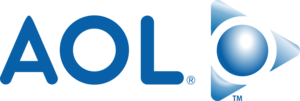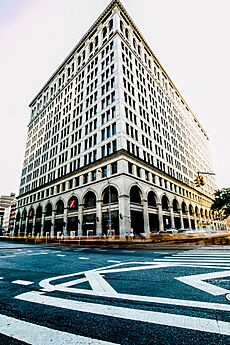AOL facts for kids
 |
|
|
Formerly
|
|
|---|---|
| Subsidiary | |
| Traded as | NYSE: AOL |
| Founded |
|
| Founders |
|
| Headquarters | 770 Broadway,
New York City
,
U.S.
|
|
Area served
|
Worldwide |
| Services | Web portal and online services |
|
Number of employees
|
5,600 |
| Parent |
|
AOL is an American company that provides online services and a web portal. It is based in New York City and is now a brand managed by Yahoo! Inc..
AOL's story began with an online service called PlayNET. Its software was used by Quantum Link (Q-Link), which started in November 1985. A new version for IBM PC computers launched in 1988. This service was later renamed America Online in 1989. AOL grew to become the biggest online service, becoming more popular than older companies like CompuServe. By 1995, AOL had about three million active users.
At one point, AOL was one of the most recognized internet brands in the United States. It offered dial-up Internet to millions of people. AOL also helped make instant messaging and chat rooms popular with its AOL Instant Messenger (AIM). In 1998, AOL bought Netscape. By 2000, AOL provided internet service to over 20 million customers. In 2001, at its peak, AOL bought the media company Time Warner. This was the largest merger in US history at the time. AOL's popularity then quickly decreased, partly because dial-up internet was replaced by faster broadband. AOL separated from Time Warner in 2009. The company then focused on media and advertising.
On June 23, 2015, Verizon Communications bought AOL for $4.4 billion. Later, on May 3, 2021, Verizon announced it would sell Yahoo and AOL to a company called Apollo Global Management. Since September 1, 2021, AOL has been part of the new Yahoo! Inc..
History of AOL
The Early Years (1983–1991)
AOL started in 1983 as a company called Control Video Corporation (CVC). It was founded by William von Meister. Their first product was an online service called GameLine for the Atari 2600 video game console. Users bought a modem and paid a fee to download games temporarily.
In 1983, Steve Case joined Control Video as a marketing consultant. In 1985, Jim Kimsey helped the company, which was almost out of money. William von Meister left the company in early 1985.
On May 24, 1985, Quantum Computer Services was founded by Jim Kimsey from the remains of Control Video. Kimsey became the CEO, and Marc Seriff was the chief technology officer. In 1987, Steve Case became an executive vice-president. Kimsey prepared Case to take over as CEO, which he did in 1991.
Kimsey changed the company's plan. In 1985, they launched an online service for Commodore 64 and 128 computers called Quantum Link (or "Q-Link"). This service was different because it used the computer's power, not just a simple terminal. It offered a fixed price for home users. In 1988, Quantum and Apple launched AppleLink Personal Edition for Apple II and Macintosh computers. Later in 1988, Quantum launched PC Link for IBM-compatible PCs. After separating from Apple in 1989, Quantum changed the service's name to America Online. Steve Case promoted AOL as an easy-to-use online service for people who were new to computers.
From the very beginning, AOL included online games. Many classic and fun games were part of the original software. The company also introduced new interactive games and stories, such as:
- Graphical chat worlds like Habitat (1986–1988).
- The first online interactive story series, QuantumLink Serial (1988).
- Quantum Space, an automated game played by mail (1989–1991).
The Internet Age and Time Warner Merger (1991–2006)
In February 1991, AOL for DOS was released. A year later, AOL for Windows followed. This happened as other paid online services like Prodigy and CompuServe were also growing.
In the early 1990s, the average AOL customer stayed for about 25 months. Advertisements offered free software and trial memberships. AOL stopped Q-Link and PC Link in late 1994. In September 1993, AOL added Usenet access. This led to a huge increase in new users. AOL also started a big marketing campaign, giving out many free trial AOL CDs. At one point, half of all CDs made worldwide had an AOL logo. AOL quickly became more popular than Prodigy and CompuServe. In 1996, AOL started using a web browser based on Internet Explorer.
AOL launched services with many educational groups and institutions. These included the National Education Association, National Geographic, the Smithsonian Institution, and the Library of Congress. AOL offered the first real-time homework help service and the first online service for children (Kids Only Online, 1991). It also had the first online courses and the first parental controls.
AOL bought the search engine WebCrawler in 1995 but sold it to Excite the next year. After that, AOL launched its own search engine, NetFind, which was based on Excite. It was renamed AOL Search in 1999.
AOL charged users by the hour until December 1996. Then, it switched to a flat monthly rate of $19.95. This change caused many users to try to connect at once, leading to busy signals. Many people canceled their accounts because of this. Within three years, AOL had 10 million users. In 1996, AOL moved its headquarters to Dulles, Virginia, to allow for more growth. AOL was also included with Microsoft Windows software.
By 1997, about half of all US homes with Internet access used AOL. AOL's content channels, like News and Sports, grew significantly. In February 1998, AOL acquired CompuServe.
In November 1998, AOL announced it would buy Netscape, known for its web browser, in a $4.2 billion deal. This deal was completed in March 1999. Another big purchase was MapQuest in December 1999 for $1.1 billion.
In January 2000, AOL and Time Warner announced plans to merge, creating AOL Time Warner, Inc. This was the largest merger in history at the time. The new company was led by executives from both AOL and Time Warner. Steve Case became chairman. In 2003, AOL Time Warner removed "AOL" from its name.
In 2004, AOL launched AOL 9.0 Optimized, which allowed users to have personalized greetings. In 2005, AOL streamed the Live 8 concert live online. Later in 2005, AOL released the AOL Safety & Security Center, which included antivirus and anti-spyware software. In December 2005, Google bought a 5% share of AOL for $1 billion.
Rebranding and Decline (2006–2009)
On April 3, 2006, AOL announced it would no longer use the full name America Online. The official name became AOL. On June 8, 2006, AOL offered a new program called AOL Active Security Monitor. Two months later, AOL released AOL Active Virus Shield, a free product.
In August 2006, AOL started offering free email accounts and software that were previously only for paying customers. This was done to reduce costs and encourage users to access AOL.com through their own internet connections. Other free services included:
- AIM (AOL Instant Messenger)
- AOL Video, which had professional content and allowed users to upload videos.
- AOL Local, for finding local information like restaurants.
- AOL News
- AOL My eAddress, for custom email addresses.
- Xdrive, which allowed users to back up files online. It offered a free 5 GB account.
Also in August, AOL increased the price of its dial-up access to $25.90. This was to encourage users to switch to broadband. However, AOL later offered unlimited dial-up for $9.95 a month.
In December 2006, AOL closed its last call center in the United States. Customer support is now provided from centers in India and the Philippines.
On September 17, 2007, AOL announced it would move one of its main offices from Dulles, Virginia, to New York City. This showed the company's new focus on advertising. AOL still kept important operations in Dulles. As part of this move, AOL announced plans to lay off 2,000 employees worldwide by the end of 2007. This was about 40% of AOL's employees.
By November 2007, AOL had 10.1 million subscribers. On January 3, 2008, AOL closed its data center in Reston, Virginia. On February 6, Time Warner CEO Jeff Bewkes announced that Time Warner would separate AOL's internet-access and advertising businesses.
On March 13, 2008, AOL bought the social networking site Bebo for $850 million. On July 25, AOL announced it was closing Xdrive, AOL Pictures, and BlueString to save money. AOL Pictures closed on December 31. On October 31, AOL Hometown (a web-hosting service) and AOL Journal (a blog hosting service) were also closed.
As a Digital Media Company (2009–2015)
On March 12, 2009, Tim Armstrong, who used to work at Google, became the new CEO of AOL. On May 28, Time Warner announced that AOL would become an independent company. On November 23, AOL revealed a new brand logo. On December 10, AOL began trading independently on the New York Stock Exchange.
On April 6, 2010, AOL announced plans to close or sell Bebo. On June 16, Bebo was sold for about $10 million. In December, AIM stopped allowing access to AOL chat rooms because fewer people were using them.
Under Tim Armstrong, AOL focused on a new business direction and bought several companies. It acquired Patch Media, which is a network of local news websites. On September 28, 2010, AOL bought TechCrunch, a popular technology news website. On December 12, 2010, AOL acquired about.me, a personal profile platform.
On January 31, 2011, AOL bought goviral, a European video distribution network. In March 2011, AOL acquired HuffPost for $315 million. After this, Huffington Post co-founder Arianna Huffington became the president and editor-in-chief of the AOL Huffington Post Media Group. On March 10, AOL announced it would cut about 900 jobs after the HuffPost acquisition.
On September 14, 2011, AOL formed a partnership with Yahoo and Microsoft to sell ads together. This strategy was designed to help them compete with Google.
On February 28, 2012, AOL worked with PBS to launch MAKERS. This was a digital documentary series about successful women in fields often dominated by men.
On March 15, 2012, AOL bought Hipster, a mobile photo-sharing app. On April 9, 2012, AOL announced a deal to sell 800 patents to Microsoft for over $1 billion. AOL kept a license to use these patents.
In April 2012, AOL expanded its online video advertising. The company launched the AOL On network, a single website for all its video content.
In February 2013, AOL reported its first increase in quarterly revenue in eight years.
In August 2013, Armstrong announced that Patch Media would reduce its operations or sell many of its local news sites. Layoffs began, affecting up to 500 positions. On January 15, 2014, Patch Media became a separate company. By the end of 2014, AOL controlled a small part of the global advertising market.
On January 23, 2014, AOL acquired Gravity, a software company that tracked user behavior to show tailored ads. This deal was worth $83 million. Later that year, AOL acquired Vidible, a company that helped websites show video content from other publishers. This deal was reportedly worth about $50 million.
On July 16, 2014, AOL received an Emmy nomination for its original series The Future Starts Here. This series focused on how humans interact with technology.
Part of Verizon (2015–2021)
On May 12, 2015, Verizon announced plans to buy AOL for $4.4 billion. The deal was completed on June 23. Armstrong continued to lead AOL. He said the deal was important for AOL's future growth. Analysts believed the deal would help Verizon's advertising and video production. At the time of the buyout, AOL still had about two million dial-up subscribers.
Shortly before the Verizon purchase, on April 14, 2015, AOL launched ONE by AOL. This was a digital marketing platform to manage advertising campaigns across different screens. On September 15, AOL expanded this product for creative and media agencies.
On May 8, 2015, AOL reported its first-quarter revenue of $625.1 million. Most of this came from advertising.
On June 29, 2015, AOL announced a deal with Microsoft to take over most of its digital advertising business. About 1,200 Microsoft employees involved in advertising moved to AOL. AOL also took over selling ads on various Microsoft platforms in nine countries. Additionally, Google Search on AOL properties was replaced with Bing.
On July 22, 2015, AOL received two News and Documentary Emmy nominations. One was for MAKERS, and the other for True Trans With Laura Jane Grace, a documentary about a transgender musician.
On September 3, 2015, AOL agreed to buy Millennial Media for $238 million. This acquisition was completed on October 23, 2015.
On October 1, 2015, Go90 launched. This was a free mobile video service for young adults and teens, owned by Verizon and managed by AOL. It included content from Comedy Central, HuffPost, and ESPN.
On April 20, 2016, AOL acquired RYOT, a virtual reality studio. This was to bring 360-degree video and VR content to HuffPost's audience.
In July 2016, Verizon Communications announced it would buy the main internet business of Yahoo!. Verizon combined AOL with Yahoo into a new company called "Oath Inc." In January 2019, Oath Inc. rebranded itself as Verizon Media.
In November 2020, the Huffington Post was sold to BuzzFeed.
Under Apollo Global Management (2021–Present)
On May 3, 2021, Verizon announced it would sell 90 percent of its Verizon Media division to Apollo Global Management for $5 billion. This division then became the second version of Yahoo! Inc..
AOL's Products and Services
Content and Media
As of September 1, 2021, the following media brands are part of AOL's parent company, Yahoo Inc.:
- Engadget
- Autoblog
- TechCrunch
- Built by Girls
AOL's content comes from over 20,000 bloggers. These include politicians, celebrities, and experts who write about many news topics.
AOL also creates mobile apps for its properties like Autoblog, Engadget, The Huffington Post, and TechCrunch.
Advertising Services
AOL has many media brands and advertising services for mobile, desktop, and TV. These services include brand partnerships and sponsorships through its Partner Studio by AOL. They also offer data and programmatic advertising through their ad technology system, ONE by AOL.
AOL acquired several businesses to build ONE by AOL, including AdapTV in 2013 and Convertro, Precision Demand, and Vidible in 2014. ONE by AOL has different parts for publishers and advertisers.
On September 10, 2018, AOL's parent company, Oath, combined its advertising services to create Oath Ad Platforms, now known as Yahoo! Ad Tech.
Membership and Communication
AOL offers various products and services, including communication tools, mobile apps, and subscription packages.
Before AIM was stopped in 2017, billions of messages were sent daily on AIM and AOL's other chat services.
- Dial-up Internet access – While 2.1 million people still used AOL's dial-up service in 2015, only a few thousand were subscribed in 2021.
- AOL Mail – This is AOL's own email service. It was connected with AIM and showed news headlines from AOL content sites.
- AOL Instant Messenger (AIM) – This was AOL's instant-messaging tool, released in 1997. It also had a video-chat service. AOL stopped AIM on December 15, 2017.
- AOL Plans – These plans offer online safety and help tools, such as identity protection, data security, and general online technical assistance.
AOL Desktop Software
| Developer(s) | AOL |
|---|---|
| Initial release | December 8, 2007 |
| Stable release |
9.8(Windows)
1.7 (macOS) / August 10, 2015 |
| Preview release |
11.0.3418 / November 11, 2021.
|
| Written in | C++ |
| Operating system | Microsoft Windows XP or later, Mac OS X 10.4.8 or later |
| Type | Internet Suite |
| License | Proprietary |
AOL Desktop is an internet program created by AOL in 2007. It combines a web browser, a media player, and an instant messenger client. Version 10.X was based on AOL OpenRide. The macOS version used WebKit.
AOL Desktop version 10.X was different from earlier AOL browsers. It focused on web browsing and email. You did not have to sign into AOL to use it as a regular browser. You could also access non-AOL email accounts through it. Primary buttons included "MAIL" and "IM," along with shortcuts to web pages. Later, AOL Desktop version 10.X was no longer supported, and focus shifted to the 9.X versions.
Version 9.8 was released, which used CEF (Chromium Embedded Framework) for its web browser parts. This gave users a better web browsing experience, similar to Chrome.
Version 11 of AOL Desktop was completely rewritten but kept a similar look to the 9.8.X series.
In 2017, a new paid version called AOL Desktop Gold was released for $4.99 per month after a trial. It replaced the previous free version. After AIM shut down in 2017, AOL's original chat rooms were still available through AOL Desktop Gold. However, that chat system was shut down on December 15, 2020.
In addition to AOL Desktop, the company also offered a browser toolbar called AOL Toolbar. This was a Mozilla plug-in for several web browsers that gave quick access to AOL services. The toolbar was available from 2007 until 2018.
See also
 In Spanish: AOL para niños
In Spanish: AOL para niños
- Adrian Lamo – Inside-AOL.com
- AOHell
- Comparison of webmail providers
- David Shing
- Dot-com bubble
- Elwood Edwards
- List of acquisitions by AOL
- List of S&P 400 companies
- Live365
- Truveo








